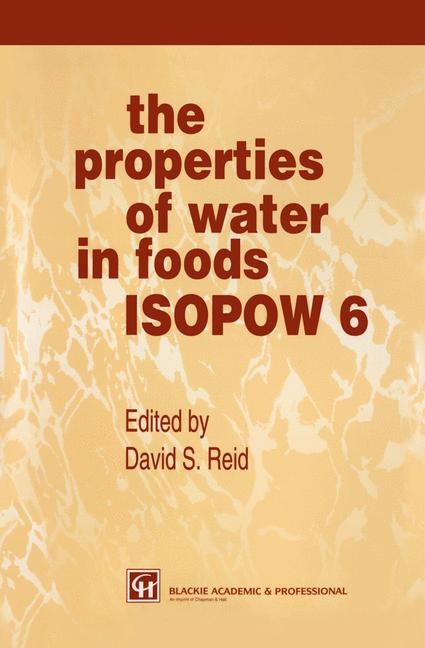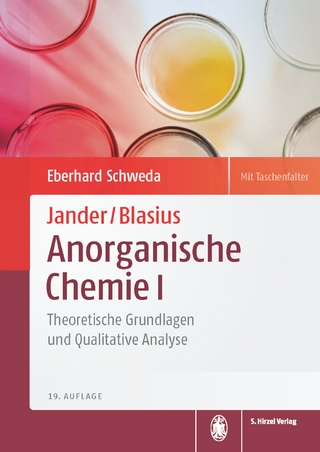
The Properties of Water in Foods ISOPOW 6
Chapman and Hall (Verlag)
978-0-7514-0382-4 (ISBN)
- Titel ist leider vergriffen;
keine Neuauflage - Artikel merken
1 High Moisture Systems.- 1 Supramolecular structures of biopolymer gels.- 1.1 Introduction.- 1.2 Complexity of polysaccharide gels.- 1.2.1 Cationic effects.- 1.2.2 Effects of a second polysaccharide.- 1.2.3 Effects of added proteins.- 1.3 Process manipulation.- 1.3.1 Heat versus high pressure treatments of mixed protein gels.- 1.3.2 Kinetics of heating.- 1.4 Structure engineering.- 1.4.1 Image analysis of structure parameters.- 1.4.2 Correlations with perceived texture.- Acknowledgements.- References.- 2 Water in tissue structures by NMR and MRI.- 2.1 Introduction.- 2.1.1 MRI principles.- 2.1.2 NMR image generation.- 2.1.3 Contrast in NMR images.- 2.2 Application examples.- 2.2.1 Measurement of quality.- 2.2.2 Determination of sample structure.- 2.2.3 Single cell imaging.- References.- 2 Intermediate Moisture Systems.- 3 Physical chemical parameters inhibiting the growth of microorganisms.- Abstract.- 3.1 Introduction.- 3.2 Food mixtures (composite foods) and the equilibration of water activity between layers of different composition.- 3.2.1 Pasteurized filled pasta.- 3.2.2 Shelf-stable soft sponge bars.- 3.3 Comparison of literature values of minimal aw for growth with observed behavior (growth/inhibition) in actual foods.- 3.4 Role of the glassy state in microbial growth inhibition.- 3.5 pH of reduced-moisture foods.- Acknowledgements.- References.- 4 Protein hydration and glass transitions.- 4.1 Introduction.- 4.2 Protein dynamics — a comparison with glass-forming systems.- 4.2.1 Strong and fragile liquids.- 4.2.2 The 200 K transition in hydrated proteins.- 4.2.3 Water as plasticizer — the hydration dependence of Tg.- 4.3 Hydrogen exchange evidence for dynamically distinct protein substructures.- 4.3.1 Properties of the slow exchange core (knots).- 4.3.2 Enthalpy–entropy compensation behavior.- 4.3.3 The basis of knot formation — the cooperative contraction process.- 4.4 Relationship between hydrogen exchange and glass transition behavior.- 4.5 Kinetic and thermodynamic stability of proteins.- 4.5.1 Effect of hydration on protein stability.- 4.6 Protein folding.- 4.7 Concluding remarks.- Acknowledgements.- References.- 3 Low Moisture Systems.- 5 Thermodynamic and kinetic features of vitrification and phase transformations of proteins and other constituents of dry and hydrated soybean, a high protein cereal.- Abstract.- 5.1 Introduction.- 5.2 Experimental methods.- 5.3 Results.- 5.4 Discussion.- 5.4.1 Superposition of endothermic and exothermic features and the resulting artefact.- 5.4.2 Vitreous character of the cooled state.- 5.4.3 Melting of the crystallized constituents and ice.- 5.4.4 Coexistence of ice, protein and the liquid phase.- 5.4.5 Crystallization kinetics of ice from the liquid phase.- Acknowledgements.- References.- 6 NMR dynamics properties of water in relation to thermal characteristics in bread.- Abstract.- 6.1 Introduction.- 6.2 Characterization of transitions from tan ? curves.- 6.3 Molecular investigation by solid state 1H and 2H NMR.- 6.4 Solid and liquid fraction of starch by cross relaxation.- 6.5 Rates of events.- 6.6 Changes in water mobility during bread staling.- 6.7 Conclusions.- Acknowledgements.- References.- 7 Phase and polymorphic transitions of starches at low and intermediate water contents.- Abstract.- 7.1 Introduction.- 7.2 Materials and methods.- 7.2.1 Materials.- 7.2.2 Methods.- 7.3 Results and discussion.- 7.3.1 Structuring role of water.- 7.3.2 Water may induce some polymorphic transitions.- 7.3.3 Heating at low and intermediate moisture contents.- 7.3.4 Melting at low and intermediate moisture contents.- 7.4 Conclusions (overview).- Acknowledgements.- References.- 8 Thermal properties of polysaccharides at low moisture: Part 3 — Comparative behaviour of guar gum and dextran.- 8.1 Introduction.- 8.2 Materials and methods.- 8.3 Results.- 8.4 Discussion.- References.- 4 Drying.- 9 Spray drying of high fat foods.- Abstract.- 9.1 Introduction.- 9.2 Equipment and materials.- 9.3 Properties of spray dried product.- 9.3.1 Morphology and particle size.- 9.3.2 Composition.- 9.3.3 Stickiness.- 9.4 Drying model.- 9.4.1 Sorption isotherm.- 9.4.2 Diffusion coefficient.- 9.4.3 Simulations.- 9.5 Simple heuristic free fat model.- 9.6 Conclusions.- 9.7 Symbols.- Acknowledgements.- References.- 10 Spray drying and quality changes.- Abstract.- 10.1 Introduction.- 10.2 The process.- 10.3 Elaboration of the physical structure of powder during spray drying.- 10.3.1 Atomization.- 10.3.2 Control of moisture content.- 10.3.3 Physical properties of particles.- 10.3.4 Bulk properties.- 10.4 Composition changes during spray drying.- 10.4.1 Thermal history of product during spray drying.- 10.4.2 Sugar-containing powders.- 10.4.3 Retention of volatiles.- 10.4.4 Encapsulation of lipids.- 10.4.5 Spray dried fats.- 10.5 Conclusions.- References.- 11 Mechanical properties of dry brittle cereal products.- 11.1 Introduction.- 11.2 Mechanical terminology.- 11.3 Characterization of irregular and irreproducible force-deformation relationships.- 11.3.1 Stiffness assessment.- 11.3.2 Jaggedness assessment.- 11.4 Jaggedness measures.- 11.4.1 Standard deviation.- 11.4.2 Apparent fractal dimension.- 11.5 Fourier transform.- 11.6 Other mechanical measures.- 11.7 Effects of moisture.- 11.8 Effects of temperature.- 11.9 Effects of plasticizers/antiplasticizers.- 11.10 Conclusions.- Acknowledgements.- References.- 12 Stress development in shrinking slabs during drying.- Abstract.- 12.1 Introduction and literature review.- 12.2 Model development.- 12.2.1 Mechanistic description off biopolymer drying.- 12.2.2 Mathematical development.- 12.3 Results and discussion.- 12.4 Conclusions.- References.- 5 Freezing.- 13 Freezing — nucleation in foods and antifreeze actions.- 13.1 Introduction.- 13.2 Nucleation.- 13.3 Growth.- 13.4 Recrystallization.- 13.5 Antifreeze polymers.- 13.6 Mobility temperature.- 13.7 Summary.- References.- 14 Mechanisms and kinetics of recrystallization in ice cream.- Abstract.- 14.1 Introduction.- 14.2 Mechanisms of recrystallization.- 14.2.1 Migratory recrystallization.- 14.2.2 Isomass recrystallization.- 14.2.3 Accretion.- 14.2.4 Melt-refreeze recrystallization.- 14.2.5 Irruptive recrystallization.- 14.3 Factors affecting recrystallization.- 14.3.1 Initial freezing process.- 14.3.2 Hardening rate.- 14.3.3 Storage temperature and temperature fluctuations.- 14.3.4 Composition of ice cream.- 14.4 Summary.- Acknowledgements.- References.- 15 Biological ice nucleation.- 15.1 Identity and features of ice-nucleating microorganisms.- 15.2 Genetic and biochemical determinants of bacterial ice nucleation.- 15.3 Environmental effects on ice nucleation.- 15.4 Aggregation model of ice nucleation.- 15.5 Structural models of Ice proteins.- 15.6 Summary.- References.- 16 Formation of ice in frozen foods and its control by physical stimuli.- 16.1 Introduction.- 16.2 Nucleation of ice crystals.- 16.2.1 Phase diagram.- 16.2.2 Homogeneous nucleation.- 16.3 Experimental induction of ice nucleation by physical methods.- 16.3.1 Early experiments.- 16.3.2 Promotion of nucleation by friction.- 16.3.3 Onset of freezing following the passage of a shock wave.- 16.3.4 Nucleation by vibration and tearing.- 16.3.5 Nucleation by growth or collapse of cavities.- 16.3.6 Nucleation following electrostatic disruption of water droplets.- 16.3.7 Conclusions drawn from experimental demonstrations.- 16.4 Theoretical discussion of nucleation of ice crystals by physical means.- 16.4.1 Nucleation through increase in local acoustic pressure.- 16.4.2 Cavitation.- 16.4.3 Cavitation threshold in water.- 16.4.4 Dynamics of a cavity in water.- 16.4.5 Vapour filled cavities.- 16.4.6 Transient cavitation.- 16.4.7 Cavitation prediction graphs.- 16.4.8 Generation of high pressures by transient bubble collapse.- 16.4.9 Hickling’s theory of nucleation of ice in supercooled water by collapsing cavities.- 16.5 Conclusions.- References.- 6 Water at High Pressures.- 17 Effects of high pressure on food biopolymers with special reference to ?-lactoglobulin.- Abstract.- 17.1 Basic principles underlying the effects of high pressure on macromolecules.- 17.1.1 General aspects.- 17.1.2 Water-mediated effects of high pressure on protein interactions.- 17.1.3 Pressure-induced unfolding of proteins.- 17.2 Pressure-induced aggregation of ?-lactoglobulin and the role of SH/S-S interchange reaction.- 17.2.1 Influence of type of buffer (pH 7) and of pressure level.- 17.2.2 Influence of pressurization time.- 17.2.3 Determination of SH groups.- 17.2.4 Influence of gas atmosphere.- 17.2.5 Influence of N-ethylmaleimide and of reducing agents.- 17.3 Pressure-induced gelation of ?-lactoglobulin.- 17.3.1 Microstructure: effects of protein or sucrose concentration.- 17.3.2 Mechanical and biochemical characteristics: effects of polyols, calcium ions and time after pressure release.- 17.3.3 Effects of pressurization time.- 17.3.4 Effects of pH and type of buffer.- 17.4 Influence of pressure on the formation of pectin gels.- 17.5 Effects of high pressure on starch granules.- Acknowledgements.- References.- 18 Inactivation of microorganisms by high pressure.- Abstract.- 18.1 Introduction.- 18.2 Materials and methods.- 18.2.1 Organisms.- 18.2.2 Media and culture conditions.- 18.2.3 Carbohydrates.- 18.2.4 Heat treatment.- 18.2.5 Pressure treatment.- 18.2.6 Measurement of internal pH.- 18.2.7 Preparation of membrane vesicles and measurement of ATPase activity.- 18.2.8 Lag time determinations.- 18.3 Mathematical analysis of inactivation data.- 18.3.1 Log-logistic analysis.- 18.4 Results and discussion.- 18.4.1 Inactivation by heat and by pressure.- 18.4.2 Lag times.- 18.4.3 Effect of environmental conditions on inactivation by pressure and heat.- 18.4.4 Mechanistic aspects: effect of culture conditions on pressure resistance.- 18.5 Conclusions.- References.- 19 Advantages, possibilities and challenges of high pressure applications in food processing.- 19.1 Introduction.- 19.2 Advantages of high pressure treatment of foods.- 19.3 Opportunities for high pressure processing of foods.- 19.3.1 High pressure blanching.- 19.3.2 Pressure-assisted dehydration/rehydration processes.- 19.3.3 Pressure-assisted frying processes.- 19.3.4 Pressure-assisted extraction processes.- 19.3.5 Pressure-assisted bioconversion processes.- 19.3.6 Pressure-assisted preservation processes.- 19.3.7 Pressure-assisted gelling of protein and polysaccharides.- 19.3.8 Pressure-assisted reduction/removal of antinutritional factors.- 19.3.9 Pressure-assisted plant tissue texture retention/enhancement.- 19.3.10 Pressure shift freezing.- 19.3.11 Pressure thawing.- 19.4 Challenges of high pressure processing of foods.- 19.4.1 Inactivation kinetics of spore-forming bacteria.- 19.4.2 Mechanisms of high pressure effects on biological systems (microbial morphology).- 19.4.3 Mechanisms of high pressure effects on biological systems (plant cell culture model systems).- 19.4.4 Interactions between food components and high pressure.- 19.5 Conclusions.- Acknowledgements.- References.- 7 Biological Systems’ Response to Water Stress.- 20 Anhydrobiosis: the water replacement hypothesis.- 20.1 Introduction.- 20.2 Destabilization of membranes during drying.- 20.2.1 Fusion.- 20.2.2 Lipid phase transitions.- 20.3 Mechanism of interaction between sugars and dry phospholipids.- 20.3.1 Vitrification.- 20.3.2 Can vitrification affect Tm in dry phospholipids?.- 20.3.3 Retention of water by dry vesicles.- 20.3.4 Direct interaction.- 20.4 Does trehalose have special properties?.- 20.5 Trehalose as a chemical chaperone.- 20.6 Summary and conclusions.- References.- 21 Bacterial responses to osmotic stress: diverse mechanisms to achieve a common goal.- Abstract.- 21.1 Introduction.- 21.2 Compatible solute accumulation: strategy for ameliorating effects of low water activity.- 21.2.1 Compatible solutes in food.- 21.2.2 Effects of osmotic stress.- 21.2.3 Sensing osmotic stress.- 21.2.4 Water transport in bacterial cells.- 21.2.5 Water flow and turgor regulation.- 21.2.6 Stretch-activated channels.- 21.2.7 Kinetics, stretch-activated channels, elastic modulus of the cell wall and turgor pressure.- 21.2.8 Overview.- 21.3 Safety net: stress survival, stationary phase sigma factor RpoS and osmotic regulation.- 21.3.1 Regulation of RpoS protein accumulation.- 21.3.2 RpoS and osmotic shock.- 21.4 Osmotic regulation of gene expression.- 21.4.1 proU, H-NS and DNA topology.- 21.4.2 Regulatory mechanisms for other osmotically regulated genes.- 21.5 Conclusions.- Acknowledgements.- References.- 22 Bacterial spores — resistance, dormancy and water status.- 22.1 Introduction.- 22.2 Heat resistance.- 22.2.1 Spore characteristics important for acquired heat resistance.- 22.3 Targets for heat damage and radical involvement in spore killing.- 22.3.1 Nature of heat killing.- 22.3.2 Molecular Targets.- 22.4 Future directions.- Acknowledgements.- References.
| Erscheint lt. Verlag | 31.7.1997 |
|---|---|
| Zusatzinfo | 76 Illustrations, black and white; XXI, 512 p. 76 illus. |
| Verlagsort | London |
| Sprache | englisch |
| Gewicht | 1160 g |
| Themenwelt | Naturwissenschaften ► Chemie ► Analytische Chemie |
| Technik ► Lebensmitteltechnologie | |
| ISBN-10 | 0-7514-0382-2 / 0751403822 |
| ISBN-13 | 978-0-7514-0382-4 / 9780751403824 |
| Zustand | Neuware |
| Haben Sie eine Frage zum Produkt? |
aus dem Bereich


